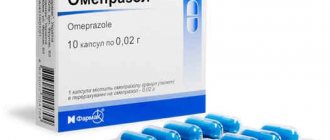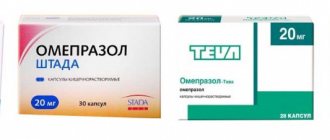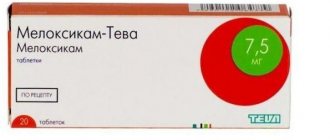Instructions for use
- 1. Peptic ulcer and duodenum (including relapses);
- 2. Ulcerative lesions of the duodenum and stomach, which appeared in connection with the use of various drugs; also provoked by Helicobacter pylori;
- 3.Zollinger-Ellison syndrome;
- 4. Various pathological conditions caused by increased gastric secretion.
Method of administration.
The dosage of the drug is individual. Capsules are taken orally before meals. The capsules are not chewed and should be washed down with a small amount of water.
Dosage for adults.
For peptic ulcer, duodenal ulcer, reflux esophagitis, take 20 mg once a day for a month. Depending on the case, you can increase the dose to 40 mg per day.- For Zollinger-Ellison syndrome, the dose is individual. It is recommended to take 60 mg once a day after meals. As prescribed by the doctor, the dose can be increased to 80-120 mg per day, then it is taken twice.
- For ulcerative lesions of the duodenum and stomach caused by Helicobacter pylori, capsules of 20 mg are taken 2 times a day in conjunction with antibacterial drugs for a week.
Children are not recommended to take this drug , as there is no clinical research.
For elderly people, the dose is the same as for adults; no dose adjustment is required.
In patients with liver disease, the maximum daily dose is 20 mg.
If you have difficulty swallowing the capsule, you can mix its contents with liquid, such as juice, and consume it within half an hour.
Composition and release form.
Omeprazole - Teva is available in capsules that dissolve in the intestines. Dosage 10 mg, 20 mg and 40 mg.
One 10 mg capsule contains:
- The main treatment component is omeprazole 10.00 mg;
- Excipients : oleic acid, granulated sugar, sodium carboxymethyl starch, sodium lauryl sulfate, povidone, triethyl citrate, hypromellose, potassium oleate;
- Cellulose structure : carrageenan, titanium dioxide, potassium chloride, water, red iron oxide dye.
Interaction with other drugs
- Omeprazole should not be used together with St. John's wort preparations;
- When taking omeprazole and clarithromycin simultaneously, their amount in the blood plasma increases several times;
- It is contraindicated to use omeprazole and atazanavir at the same time;
- The absorption of vitamin B12 decreases with long-term use of omeprazole;
- Warfarin, iminramin, cytolopram, hexabarbital, clomipramine, phenytoin, diazspam are eliminated from the body more slowly when used simultaneously with Teva omeprazole;
- When using omeprozole with propranolol, metoprolol, quinidine, caffeine, estradiol, diclofenac, no contraindications or changes were identified.
Omeprazole-Teva caps 40 mg No. 28 91330
Description
Omeprazole-Teva Latin name Active substance ATC: Pharmacological group Indications Contraindications Use during pregnancy and lactation Side effects Precautionary measures Special instructions Storage conditions of the drug Omeprazole-Teva Shelf life of the drug Omeprazole-Teva capsules, enteric 40 mg; blister 7, cardboard pack 4; EAN code: 3850114230902; No. LP-001970, 2013-01-14 from Teva (Israel); manufacturer: Teva Pharma, SLU (Spain) Omeprazole-Teva Omeprazole * (Omeprazolum) A02BC01 Omeprazole Proton pump inhibitors Peptic ulcer of the stomach and duodenum in the acute phase, gastroesophageal reflux disease, incl. refractory to therapy with H2-antihistamines, reflux esophagitis, incl. erosive and ulcerative, pathological hypersecretory conditions (Zollinger-Ellison syndrome, polyendocrine adenomatosis, systemic mastocytosis, stress ulcer, including prevention), peptic ulcer of the gastrointestinal tract caused by Helicobacter pylori, NSAID gastroenteropathy, erosive and ulcerative lesions of the stomach and duodenum in HIV-infected patients, non-ulcer dyspepsia. Hypersensitivity, pregnancy, breastfeeding. Category of action on the fetus according to the FDA is C. During pregnancy, it is possible only for health reasons. Breastfeeding should be stopped during treatment. From the gastrointestinal tract: dry mouth, lack of appetite, nausea, vomiting, flatulence, abdominal pain, diarrhea, constipation, in some cases - changes in taste sensitivity, stomatitis and candidiasis of the gastrointestinal tract, polyposis of the fundus of the stomach, atrophic gastritis, increased activity of liver enzymes . From the nervous system and sensory organs: headache, rarely - malaise, asthenia, dizziness, sleep disturbance, drowsiness, paresthesia, in some cases - restlessness, agitation, anxiety, depression, reversible mental disorders, hallucinations, visual impairment, incl. h. irreversible. From the musculoskeletal system: in some cases - arthralgia, muscle weakness. From the cardiovascular system and blood: in some cases - thrombocytopenia, leukopenia, neutropenia, eosinopenia, pancytopenia, leukocytosis, anemia. From the genitourinary system: rarely - hematuria, proteinuria, peripheral edema, urinary tract infection. From the skin: in some cases - photosensitivity, erythema multiforme, alopecia. Allergic reactions: rarely - skin rash, urticaria, itching, in some cases - bronchospasm, angioedema, interstitial nephritis, anaphylactic shock. Other: in some cases - chest pain, gynecomastia. Before starting treatment, the presence of a malignant neoplasm in the gastrointestinal tract should be excluded, especially with a stomach ulcer (due to the possibility of smoothing out symptoms and increasing the time before diagnosis). Against the background of severe liver failure, treatment is possible only under close medical supervision (the dose should not exceed 20 mg/day). For patients from Asia, the need for dose adjustment is likely, especially with long-term anti-relapse treatment. When prescribing warfarin simultaneously, it is recommended to monitor the concentration of the anticoagulant in the blood serum or regularly determine the prothrombin time with subsequent dose adjustment. It must be taken into account that the following groups of patients require continuous anti-relapse therapy with omeprazole: with severe and frequent symptoms and/or endoscopically proven stage III-IV gastroesophageal reflux disease (GERD) according to Savary - Miller, in the presence of complications (Barrett's esophagus, stricture or ulcer) , long-term use of drugs that contribute to the occurrence of GERD, persistence of symptoms after healing, long duration of symptoms before starting therapy, very low basal pressure in the area of the lower esophageal sphincter. For stage II esophagitis (according to Savary - Miller), maintenance therapy is recommended after two relapses. The effectiveness of permanent therapy for GERD is increased by combination treatment with prokinetic drugs. In the case of maintenance therapy in patients with GERD associated with H. pylori, eradication of the pathogen is advisable to prevent the development of mucosal atrophy. The prepared infusion solution can be used no later than 12 hours (when dissolved in saline solution) or 6 hours (solvent - dextrose). In a dry place, protected from light, at a temperature not exceeding 25 °C. Keep out of the reach of children. 3 years. Do not use after the expiration date stated on the package. 2000-2015. Register of Medicines of Russia The database is intended for healthcare professionals. Commercial use of materials is not permitted.
Possible product names
- Omeprazole-Teva caps 40 mg No. 28
- OMEPRAZOLE-TEVA 40 MG CAPS. No. 28
- OMEPRAZOLE-TEVA 0.04 N28 CAPS
- OMEPRAZOLE-TEVA CAPS.INTESTINAL 40 MG X28
- OMEPRAZOLE-TEVA CAPS. P/O KSH/SOL. 40MG No. 28
- (Omeprazole-Teva) Omeprazole-Teva caps 40 mg No. 28
Side effects
Contraindications
- Age up to five years;
- Hypersensitivity to omeprazole;
- Chronic liver diseases;
- Breastfeeding period;
- Fructose intolerance.
During pregnancy
Clinical studies on the use of omeprazole by pregnant women have not been conducted, therefore it is not recommended for use during pregnancy .
Side effects:
- From the immune system: increased body temperature, anaphylactic shock, rash;
- From the nervous system: lethargy, headaches, insomnia, dizziness, depression (especially in older people who have been undergoing treatment for a long time);
- From the point of view: decreased visual acuity;
- From the stomach: vomiting, nausea, abdominal pain, constipation, perversion of taste (rarely);
- Skin: increased sweating, itching, rash, alopecia (rare), Steven-Johnson syndrome, photosensitivity;
- From the liver: rarely jaundice, liver failure.
- Blood disorders: anemia in children (not common), leukopenia,
In case of an overdose of omeprazole, patients experience tachycardia, nausea, headache, drowsiness, blurred vision, and arrhythmia.
Omeprazole is sold in pharmacies with a prescription.
pharmachologic effect
H+-K+-ATPase inhibitor. It inhibits the activity of H+-K+-ATPase in the parietal cells of the stomach and thereby blocks the final stage of hydrochloric acid secretion. This leads to a decrease in the level of basal and stimulated secretion, regardless of the nature of the stimulus. Due to a decrease in acid secretion, it reduces or normalizes the effect of acid on the esophagus in patients with reflux esophagitis.
Omeprazole has a bactericidal effect on Helicobacter pylori. Eradication of H. pylori with the simultaneous use of omeprazole and antibiotics allows you to quickly relieve the symptoms of the disease, achieve a high degree of healing of damaged mucosa and stable long-term remission and reduce the likelihood of bleeding from the gastrointestinal tract.
Price
Average price in Russia
The price of omeprozole in Moscow varies depending on the manufacturer and dosage. For example, production: Ozone, Russia 20 mg 20 pieces will cost you 45 rubles; manufacturer: Teva, Israel 20 mg 28 pieces costs 87 rubles; manufacturer: Kanonpharma, Russia 20 mg for 30 pieces 47 rubles. In St. Petersburg, you will pay 77.4 rubles for the same capsules. The price of the lyophilisate is about 230 rubles.
Average cost in Ukraine
In Ukraine, this drug is cheaper. For example, for omeprazole capsules for 20 mg in Odessa you will pay 28.83 UAH. In Kyiv, omeprazole in capsules 20 mg will cost you 29.25 UAH. That is, on average in Ukraine prices do not vary much.
special instructions
Before starting therapy, it is necessary to exclude the presence of a malignant process (especially with a stomach ulcer), because Treatment, masking symptoms, can delay the correct diagnosis.
Taking with food does not affect effectiveness.
If you have difficulty swallowing a whole capsule, you can swallow its contents after opening or dissolving the capsule, or you can mix the contents of the capsule with a slightly acidified liquid (juice, yogurt) and use the resulting suspension for 30 minutes.
In patients with severe liver failure, the daily dose should not exceed 20 mg.
Analogs
There are quite a lot of analogues of omeprazole-teva. For example:
omez;- gastrozol;
- Losek MAPS;
- omeprazole zentiva;
- omez insta;
- omitox;
- promez;
- ulcozol;
- de-nol;
- nolpaza;
- pentazole;
- times;
- lansofed;
- krasocid.
Reviews
There are a lot of positive reviews about omeprazole-teva.
For example, Topolina from Kemerovo reports that omeprazole-teva alleviates the condition and is cheaper than Omez. She says that a friend advised that there is no point in overpaying for the brand. Relief of stomach pain is also noted.
Many patients note a quick fight against heartburn and cope well with stomach problems.
There are many positive reviews from those who took both omez and omeprazole : the difference is only in price and excipients.










